Method for producing lactic acid bacteria controlling m cells
- Summary
- Abstract
- Description
- Claims
- Application Information
AI Technical Summary
Benefits of technology
Problems solved by technology
Method used
Image
Examples
Embodiment Construction
[0050]In order to obtain lactic acid bacteria having a size permeable to M cells with a length (4 μm or greater, 10 μm or less) suitable for galectin-9 to bind thereto, Lactobacillus salivarius is selected as lactic acid bacteria and this Lactobacillus salivarius is cultured for 30 hours or more at a temperature between 39° C. and 41° C. in a lactose-free plain soymilk as a medium. Soymilk yogurt prepared as a result of this is expected to regulate the local immune response in Peyer's patches and alleviate the symptoms of food allergy patients by suppressing the production of the inflammatory cytokine IL-6 from macrophages in food allergy patients.
Selection of Lactic Acid Bacteria
[0051]In order to isolate lactic acid bacteria contained in kumis (5 kinds of bacteria) and select lactic acid bacteria which form filaments therefrom, the culture temperature was changed from 37° C. to 48° C. Lactic acid bacteria with sizes of 4 μm or greater and 10 μm or less were selected among lactic ac...
PUM
 Login to View More
Login to View More Abstract
Description
Claims
Application Information
 Login to View More
Login to View More - R&D Engineer
- R&D Manager
- IP Professional
- Industry Leading Data Capabilities
- Powerful AI technology
- Patent DNA Extraction
Browse by: Latest US Patents, China's latest patents, Technical Efficacy Thesaurus, Application Domain, Technology Topic, Popular Technical Reports.
© 2024 PatSnap. All rights reserved.Legal|Privacy policy|Modern Slavery Act Transparency Statement|Sitemap|About US| Contact US: help@patsnap.com










